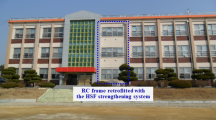Abstract
This paper describes an investigation of a high-strength concrete frame reinforced with high-strength rebars that was tested in the structure engineering laboratory at Shenyang Jianzhu University. The frame specimen was pseudodynamically loaded to indicate three earthquake ground motions of different hazard levels, after which the test specimen was subjected to a pseudo-static loading. This paper focuses on the design, construction and experiment of the test frame and validation of the simulation models. Research shows that a high-strength concrete frame reinforced with high-strength rebars is more efficient and economical than a traditional reinforced concrete frame structure. In addition to the economies achieved by effective use of materials, research shows that the frame can provide enough strength to exceed conventional reinforced concrete frames and provide acceptable ductility. The test study provides evidence to validate the performance of a high-strength concrete frame designed according to current seismic code provisions. Based on previous test research, a nonlinear FEM analysis is completed by using OpenSees software. The dynamic responses of the frame structure are numerically analyzed. The results of the numerical simulation show that the model can calculate the seismic responses of the frame by OpenSees. At the same time, the test provides additional opportunities to validate the performance of the simulation models.
Similar content being viewed by others
References
Chen CH, Hsiao PC, Lai JW, Lin ML, Weng YT and Tsai KC (2004), “Pseudo-dynamic Test of a Full-scale CFT/BRB Frame: Part 2 - Construction and Testing,” Proceedings of 13th World Conference on Earthquake Engineering, Paper No. 2175, Vancouver, Canada.
Chen CH, Lai WC, Cordova P, Deierlein GG and Tsai KC (2003), “Pseudo-dynamic Test of Full-scale RCS Frame: Part I-Design, Construction and Testing,” Proceedings, International Workshop on Steel and Concrete Composite Constructions, Centre for Research on Earthquake Engineering (NCREE), Taipei, Oct.
Code for Seismic Design of Building (GB 50011-2001), Beijing: China Architecture&Building Press. (in Chinese)
Cordova P, Chen CH, Lai WC, Deierlein GG and Tsai KC (2004) “Pseudo-dynamic Test of Full-scale RCS Frame: Part II-Analysis and Design Implicatios,” Proceedings of the 2004 Structures Congress, May, Nashville, Tennessee, 1–15.
Li Yushun, Kenichi Ohi and Shen Shizhao (2004), “Experimental and Theoretical Study on Vibration Control of Steel Frame Attached with Hysteretic Dampers,” Journal of Building Structures, 25(2): 1–7. (in Chinese)
Li Yushun, Shan Wei and Li Junhua (2010), “Study on Substructure Pseudo-dynamic Test,” China Civil Engineering Journal, 43(3): 119–123. (in Chinese)
Liang Xingwen, Wang Qinglin and Liang Yufeng (1999), “Experimental Investigation on Pseudo-dynamic Test of 1/2 Scale Model Brick Masonry Building with Frameshear Wall Structure at First Two Stories,” China Civil Engineering Journal, 32(2): 14–21. (in Chinese)
Lin ML, Weng YT, Tsai KC, Hsiao PC, Chen CH and Lai JW (2004), “Pseudo-dynamic Test of a Full-scale CFT/BRB Frame: Part 3 - Analysis and Performance Evaluation,” Proceedings of 13th World Conference on Earthquake Engineering, Paper No. 2173, Vancouver, Canada.
Liu Bingkang, Huang Shenjiang, Song Manrong, Zhou An and Jiang Yaqiong (2010), “Pseudo-dynamic Research on Post-tensioned Precast Prestressed Concrete Frame,” Journal of Earthquake Engineering and Engineering Vibration, 30(5): 65–71. (in Chinese)
Ma Lewei and Wu Minzhe (2002), “The Pseudodynamic Testing Study on the Twelve-storied Composite Structure System with Special-shaped Columns and Small-scale RC Hollow Blocks,” World Earthquake Engineering, 18 (4): 159–162. (in Chinese)
Mazzoni S, McKenna F, Scott MH and Fenves GL (2006), OpenSees Command Language Manual.
Nakashima M and Masaoka N (1999), “Real-time Online Test for MODF Systems,” Earthquake Engineering and Structural Dynamics, 28(5): 111–127.
Nakashima M and Takai H (1985), “Use of Substructure Techniques in Pseudo-dynamic Testing,” BRI Research Paper, 111(23): 350–365.
Qiu Fawei (1997a), “Application of an Unconditionally Stable Numeral Integration Algorithm in Pseudodynamic Testing,” Journal of Experimental Mechanics, 12(4): 579–586. (in Chinese)
Qiu Fawei (1997b), “Pseudo-dynamic Testing with Implicit Time Integration and Substructure Techniques,” China Civil Engineering Journal, 30(2): 27–33. (in Chinese)
Tsai KC, Weng YT, Lin ML, Chen CH, Lai JW and Hsiao PC (2003), “Pseudo-dynamic Test of a Fullscale CRT/BRB Composite Frame: Displacement Based Seismic Design and Response Evaluations,” Proceedings of International Workshop on Steel and Concrete Composite Constructions, Centre for Research on Earthquake Engineering (NCREE), Taipei, Oct.
Tsai KC, Weng YT, Lin SL and Goel S (2004), “Pseudodynamic Test of A Full-scale CFT/BRB Frame: Part 1 - Performance Based Specimen Design,” Proceedings of 13th World Conference on Earthquake Engineering, Paper No. 750,, Vancouver, Canada.
Tsutsumi H and Higashiura A (1988), “Pseudo-dynamic Testing Method Using the Newmark Implicit Integration Method,” Proceedings of Ninth World Conference on Earthquake Engineering, Tokyo-Kyoto, Japan, Vol.4.
Xiao Xiao and Yan Shi (2005), “An Analysis of Cyclic Behavior of High-strength Reinforced Concrete Columns Based on Section Layer Method,” Journal of Nanhua University (Science and Technology), 19(3): 52–55. (in Chinese)
Yan Shi, Xiao Xiao, Zhang Yueguo and Zheng Wenquan (2006a), “Numerical Analysis on Hysteresis Performances of High-strength RC Columns,” Journal of Shenyang Jianzhu University (Natural Science), 22(3): 354–356. (in Chinese)
Yan Shi, Xiao Xiao, Zhang Yueguo and Kan Lixin (2006b), “Seismic Performances of Square HSC Columns Confined with High-strength PC Rebar,” Journal of Shenyang Jianzhu University (Natural Science), 22(1): 8–10. (in Chinese)
Yan Shi, Chen Xin and Wang Linjuan (2007), “Seismic Response Analysis for High-strength Concrete Frame Structure Reinforced with Pre-stressed Rebars,” Structural Engineering, Mechanics and Computation, Cape Town, South Africa, Sep., pp. 414–419.
Author information
Authors and Affiliations
Corresponding author
Additional information
Supported by: Liaoning Provincial Natural Science Foundation of China Under Grant No. 20052005
Rights and permissions
About this article
Cite this article
Chen, X., Yan, S. & Ji, B. Pseudo-dynamic test and numerical simulation of high-strength concrete frame structure reinforced with high-strength rebars. Earthq. Eng. Eng. Vib. 10, 303–311 (2011). https://doi.org/10.1007/s11803-011-0067-z
Received:
Accepted:
Published:
Issue Date:
DOI: https://doi.org/10.1007/s11803-011-0067-z




